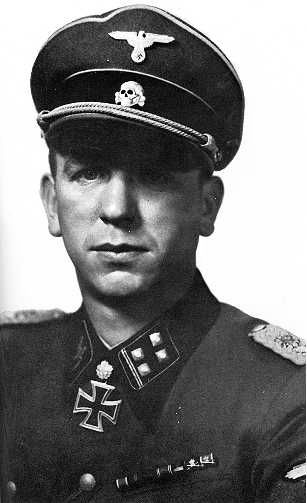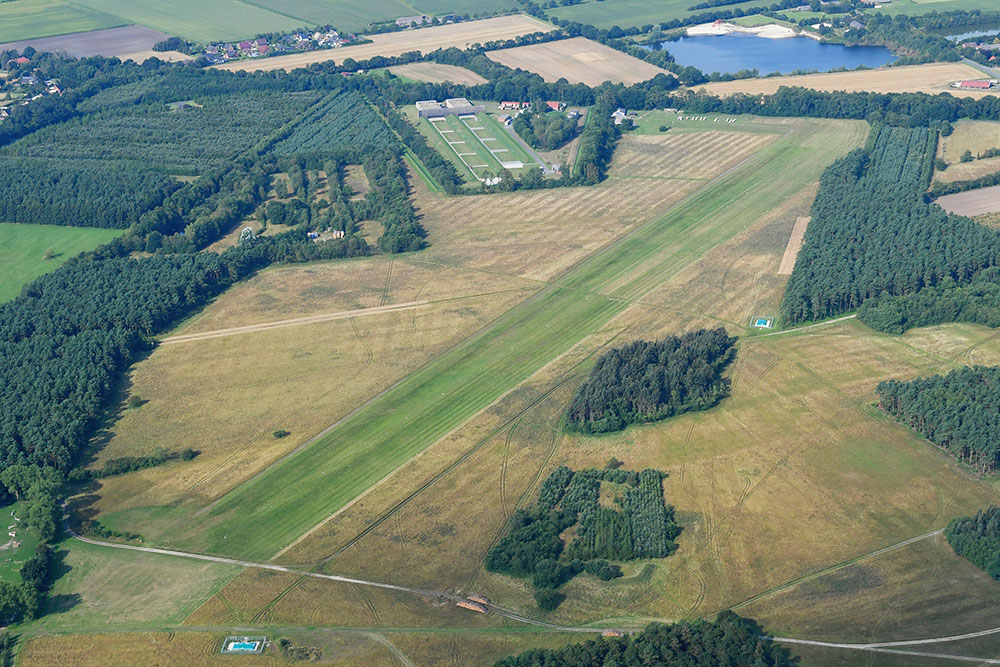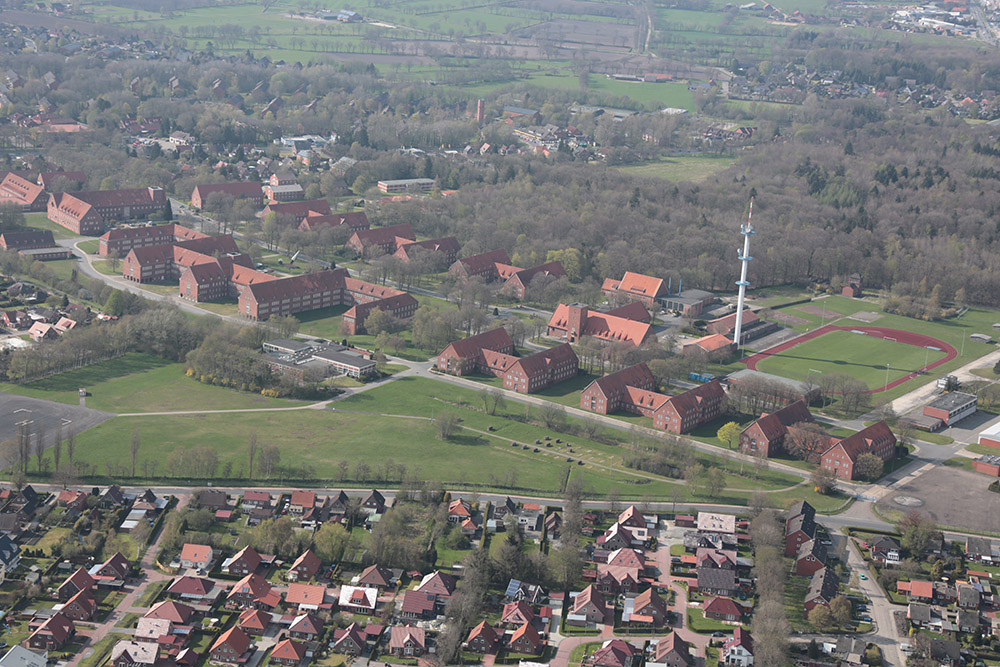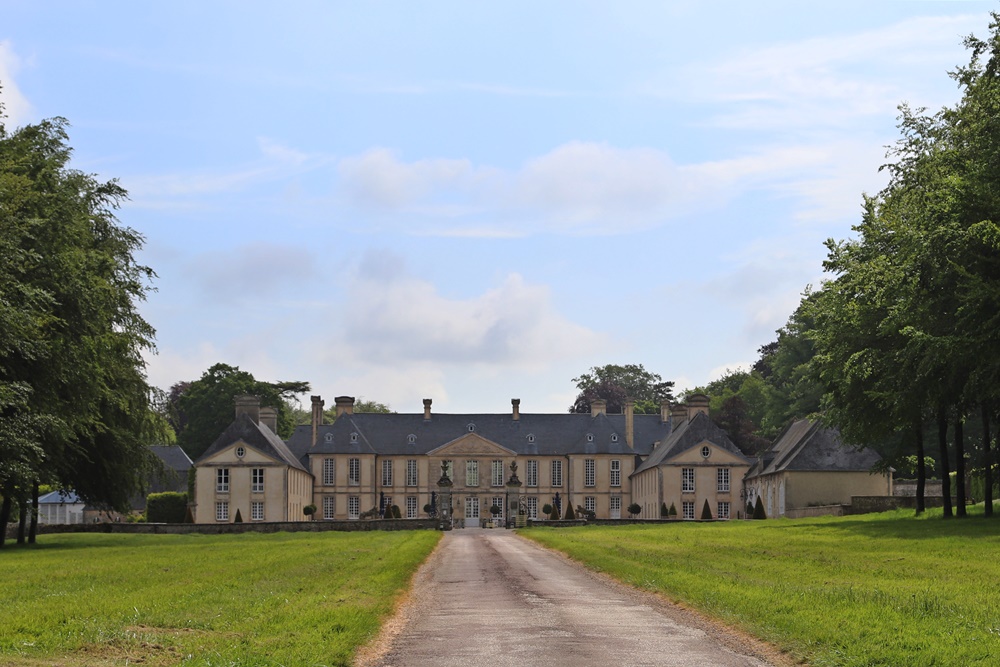Meyer, Kurt Adolph Wilhelm "Panzermeyer"
- Date of birth:
- December 23rd, 1910 (Jerxheim/Lower-Saxony, Germany)
- Date of death:
- December 23rd, 1961 (Hagen/North Rhine-Westphalia, Germany)
- Service number:
- SS-Nr.: 17.559 // NSDAP-Nr.: 316.714
- Nationality:
- German
Biography
Born to a working-class family, Meyer joined the police in 1929 after brief unemployment. A committed Nazi from youth, he entered the Hitler Youth, Nazi Party, and SS by 1931, later joining the elite LSSAH unit and participating in pre-war Nazi territorial expansions.
He led an anti-tank unit in Poland in September 1939, allegedly ordered mass executions, and fought in France and the Balkans. His aggressive tactics in Greece earned him the Knight’s Cross.
In the Soviet invasion, Meyer’s unit became infamous for civilian massacres.
In early 1943, Meyer’s unit fought in the Third Battle of Kharkov. He was awarded the Knight’s Cross with Oak Leaves for a brutal assault on Yefremovka, where his troops reportedly killed 1,500 Soviet soldiers and took no prisoners. Multiple testimonies—both from SS veterans and Ukrainian witnesses—accuse Meyer of ordering the massacre of civilians and the destruction of villages, including the killing of 872 people in Yefremovka and Semyonovka, with 240 burned alive in a church. Some accounts attribute the atrocity to Jochen Peiper’s “Blowtorch Battalion,” though Meyer was in command at the time. He remained with the LSSAH until mid-1943, then took command of a regiment in the SS Division Hitlerjugend in France.
During the Allied invasion of France in June 1944, Meyer’s SS Hitlerjugend Division counterattacked but suffered heavy losses. He halted further assaults, citing fuel shortages, and shifted to defensive positions. On 7 June, Canadian POWs were executed at Ardenne Abbey under his command.
After divisional commander Fritz Witt was killed on 14 June, Meyer took over, becoming one of the youngest German division leaders. He led the depleted division through intense fighting, suffering over 60% casualties. In August, his unit was trapped in the Falaise pocket. Meyer was wounded but escaped with the rearguard.
Awarded the Swords to the Knight’s Cross, he retreated into Belgium. On 6 September, after an ambush by U.S. forces, Meyer was discovered hiding in a barn and surrendered to Belgian partisans, who turned him over to the Americans.
After surrendering in 1944, Meyer was hospitalized following an altercation with U.S. guards, then interned in France and later at Trent Park in England. British intelligence secretly recorded him expressing unwavering Nazi beliefs, describing himself as a devoted ideological warrior. He praised Hitler and criticized Wehrmacht officers for lacking fanaticism. Despite interrogation, Meyer denied war crimes, though SS deserters later implicated him in the Ardenne Abbey massacre.
In December 1945, Meyer was tried in Aurich, Germany, for ordering or being responsible for the execution of Canadian POWs in Normandy. He faced five charges related to the deaths of 41 prisoners, including 18 at Ardenne Abbey. He pleaded not guilty and was acquitted of direct orders but found guilty of inciting troops to deny quarter and held responsible for the Abbey killings.
Though not found guilty of directly ordering murders, Meyer was sentenced to death by firing squad in 1945. One judge insisted a guilty verdict required execution. Meyer initially accepted the sentence but appealed under pressure from his wife and lawyer. The appeal was denied, but a procedural oversight delayed the execution, prompting Canadian commander Christopher Vokes to reconsider. Vokes, reflecting on wartime conduct and command responsibility, commuted the sentence to life imprisonment on 14 January 1946.
Meyer was transferred to Canada in April 1946, serving five years at Dorchester Penitentiary. In 1951, amid Cold War diplomacy and West German pressure, he was moved to a British prison in Werl. His sentence was reduced to 14 years, and he was released in 1954. Upon returning to Germany, Meyer declared support for European unity over nationalism.
fter his release, Meyer became a leading figure in HIAG, a Waffen-SS veterans’ lobby group. He defended the SS, claiming its troops were no different from the regular army and denying widespread war crimes. His 1957 memoir, Grenadiere, glorified the Waffen-SS and framed its members as victims, drawing criticism from historians.
As HIAG’s spokesperson from 1959, Meyer promoted a moderate image, distancing the group from far-right factions. He dissolved extremist chapters and met with politicians to improve the public standing of SS veterans. Despite public gestures of reconciliation, including support for protecting Jewish sites, Meyer remained privately committed to Nazi ideology.
Meyer’s health declined in later years, and he died of a heart attack in 1961. His funeral drew 15,000 attendees, reflecting his continued influence among SS veterans.
Promotions:
00.05.1925: Hitlerjunge
01.04.1928: SA-Mann
01.10.1930: Polizeiunterwachtmeister
15.10.1930: SS-Anwärter
15.02.1932: SS-Mann
10.07.1932: SS-Sturmführer
20.04.1934: Polizeioberwachtmeister
15.05.1934: SS-Untersturmführer
10.03.1935: SS-Obersturmführer
12.09.1937: SS-Hauptsturmführer
01.09.1940: SS-Sturmbannführer
09.11.1942: SS-Obersturmbannführer
21.06.1943: SS-Standartenführer
01.08.1944: SS-Oberführer
01.09.1944: SS-Brigadeführer und Generalmajor der Waffen-SS
Career:
00.05.1925: Hitlerjugend
00.04.1928: entered the SA
00.10.1929: Landespolizei Mecklenburg-Schwerin
01.09.1930: joined the NSDAP as Ortsgruppenleiter
15.10.1931: joined the SS, 2. Sturm, II. Sturmbann, SS-Standarte 22, Schwerin
15.05.1934: SS-Ustuf, Zugführer, SS-Standarte 'Leibstandarte LSSAH'
14.09.1936: SS-Ostuf, Chef, 14. (Panzer-Abwehr) Kompanie, SS-Standarte 'LAH' then 14. Kompanie, SS-Panzerjäger-Abteilung 1, SS-Standarte 'LSSAH'
00.00.1938: campaign in Austria with XVI. Armeekorps
00.09.1939: SS-Hstuf, Führer, 14. Panzerabwehr-Kompanie, SS-Standarte 'Leibstandarte', Heeresgruppe Süd - campaign in Poland - Operation Fall Weiß
07.09.1939: WIA to the shoulder
00.10.1939: alleged to have ordered the shooting of fifty Polish Jews near Modlin
20.10.1939: SS-Hstuf, Führer, 15. Kradschützen-Kompanie, SS-Standarte 'Leibstandarte', XVI. Armeekorps
00.06.1940: campaign in the West
01.09.1940-13.05.1943: SS-Stubaf, Chef, SS-Aufklärungs-Abteilung, LSSAH
00.04.1941: SS-Stubaf, campaign in Greece - Operation Marita : Kleisoura Pass, Lechovo, Lake Kastoria, Kastoria
00.06.1941: SS-Stubaf, Chef, SS-Aufklärungs-Abteilung, SS-Division 'LSSAH', Heeresgruppe Süd, campaign in Russia - Operation Barbarossa : Mariupol, Black Sea
00.10.1941-00.01.1942: ill, evacuated to Berlin
00.01.1942: SS-Stubaf, Kdr, SS-Aufklärungs-Abteilung 1, SS-Panzergrenadier-Division 'Leibstandarte SS Adolf Hitler', II. SS-Korps - recapture of Kharkov, Jeremejewka and Aleksandrowka
00.05.1943: SS-Ostubaf, Kommandeur, SS-Panzergrenadier-Regiment 25, 12. SS-Panzergrenadier-Division 'Hitlerjugend' - Beverloo Camp in Belgium
28.07.1943-26.08.1943: SS-Staf, Panzerschule Wünsdorf/Zossen
00.09.1943: SS-Staf, Kdr, SS-Panzergrenadier-Regiment 25, 12. SS-Panzergrenadier-Division 'Hitlerjugend'
00.06.1944: campaign in Normandy: Ardenne Abbey, Carpiquet Aérodrome and the villages of Contest, Buron, and Authie
16.06.1944: SS-Staf, Kdr, 12. SS-Panzergrenadier-Division 'Hitlerjugend' - Caen, Falaise, Orne River, Seine River
06.09.1944-07.09.1944: SS-Brif, WIA, captured region Spontin-Durnal near Lüttich/Namur in Belgium - POW Camp in Compiègne, France
17.11.1944-24.04.1945: sent to British POW Camp in Trent Park
10.12.1945: trialed
27.12.1945: sentenced to death
13.01.1946: sentence changed to life imprisonment
06.09.1954: released
Do you have more information about this person? Inform us!
- Period:
- Second World War (1939-1945)
- Awarded on:
- September 7th, 1939
- Period:
- Second World War (1939-1945)
- Awarded on:
- September 25th, 1939
- Period:
- Second World War (1939-1945)
- Awarded on:
- May 31st, 1940
- Period:
- Second World War (1939-1945)
- Awarded on:
- October 3rd, 1940
- Period:
- Second World War (1939-1945)
- Rank:
- SS-Sturmbannführer (Major)
- Unit:
- Kommandeur, SS-Aufklärungs-Abteilung, Infanterie-Regiment "Leibstandarte-SS Adolf Hitler" (motorisiert), Waffen-SS
- Awarded on:
- May 18th, 1941
“… On the 13.04.1941 SS-Sturmbannführer Meyer received orders to reconnoiter towards Kastoria via the Klisura Pass. Here he achieved a success (borne of his own initiative) that decisively contributed to the swift capture of Kastoria by cutting off the retreat route to the city for significant elements of the Greek’s northern wing. Sturmbannführer Meyer had already played a major role in the success of the LSSAH during the western campaign whilst serving as commander of a Vorausabteilung.”
291st Award.
- Period:
- Second World War (1939-1945)
- Rank:
- SS-Sturmbannführer (Major)
- Unit:
- Kommandeur, SS-Aufklärungs-Abteilung, Infanterie-Regiment "Leibstandarte-SS Adolf Hitler" (motorisiert), Waffen-SS
- Awarded on:
- February 8th, 1942
Award 64/3
- Period:
- Second World War (1939-1945)
- Awarded on:
- July 6th, 1942
- Period:
- Second World War (1939-1945)
- Awarded on:
- September 3rd, 1942
- Period:
- Second World War (1939-1945)
- Awarded on:
- September 4th, 1942
- Period:
- Second World War (1939-1945)
- Awarded on:
- 1942
- Period:
- Second World War (1939-1945)
- Rank:
- SS-Obersturmbannführer (Lieutenant-colonel)
- Unit:
- Kommandeur, SS-Aufklärungs-Abteilung 1, SS-Panzergrenadier-Division "Leibstandarte-SS Adolf Hitler", Waffen-SS
- Awarded on:
- February 23rd, 1943
“I recommend the commander of the LSSAH Aufklärungs-Abteilung, SS-Obersturmbannführer Kurt Meyer, for the award of the Oakleaves to the Knight’s Cross of the Iron Cross.
Justification:
Since being awarded the Knight’s Cross to the Iron Cross on the 18.05.1941 SS-Obersturmbannführer Meyer has repeatedly distinguished himself during the campaign in the East through his outstanding personal bravery and the skillful leadership of his Aufklärungs-Abteilung.
On the 19.08.1941 Meyer succeeded in penetrating into the heavily defended city of Cherson via a deliberate flank attack from the east. This triggered the collapse of the strong hostile defensive front at Cherson. The city (along with its valuable port and industrial facilities) fell into our hands almost without damage. Numerous armed ships were destroyed, and the prevention of ferry traffic across the Dnieper significantly impaired the retreat of those enemy forces that were defending the city.
Later, following the capture of Nowaja Majatschka, the Aufklärungs-Abteilung launched a wide-ranging thrust towards the southwest. This sliced its way through the retreating enemy units up until as far as the heavily fortified strongpoint of Rf. Presbrashenka. This disrupted the retreat of strong enemy forces towards Perekop and inflicted high losses in men and materiel on the foe.
On the 15. & 16.09.1941 SS-Obersturmführer Meyer and his Aufklärungs-Abteilung launched a bold thrust eastwards in pursuit of the enemy’s 9th Army. This eventually brought the Abteilung to Ssalkowa and Genitschesk, which were both captured. With this the last railway and land connections to those Red Army forces located on the Crimea were cut off. What’s more, a train loaded with war materiel (including over 100 trucks) fell into friendly hands intact after the locomotive was shot up.
During the defense against enemy forces that had broken through in the Jelisawetowka area, the commander of the Aufklärungs-Abteilung managed to halt any further hostile advance via a skillfully conducted mobile defense along a broad front. In the subsequent offensive battles SS-Obersturmbannführer Meyer plunged into the fleeing enemy and established the bridgehead at Terpenjo despite powerful opposing resistance. This laid the groundwork for the bulk of the LSSAH to continue its pursuit of the enemy. Then, on the 05.10.1941, he [Meyer] scattered the staff of the enemy’s 9th Army in Romanowka.
On the 07.10.1941, during the thrust towards Berdjansk, SS-Obersturmbannführer Meyer entered into the city alongside strong enemy columns that were retreating towards Berdjansk from the west. By doing this he prevented the demolition of valuable armaments factories. Strong enemy forces were eliminated during the clearing of the city.
SS-Obersturmbannführer Meyer continued the pursuit on the following day, advancing alongside the fleeing enemy. Disregarding the strong hostile forces present on his extended left flank, he thrust into Mariupol against bitter resistance by a totally surprised enemy. He ultimately managed to secure control over this city of over 500000 residents, one which ranked second only to Odessa with regards to its importance as a harbour city for southern Russia. He also managed to seize control of the city’s valuable armaments facilities, and thereby preempted any demolitions work on them by the foe.
When the LSSAH was transferred to the area east of Kharkov [in 1943] SS-Obersturmbannführer Meyer and his Aufklärungs-Abteilung were the first divisional elements to detrain at Tschugujew, and afterwards they immediately took up a defensive position east of the Donez in the area Vorst. Ossinowka-Kalmyzkoje-Malinowka.
From this position Meyer executed a series of spoiling attacks against strong elements of the Russian 12th Tank Corps. Thanks to his skillful leadership the enemy (which hitherto had a relatively unimpeded advance) was held up long enough for the bulk of the Division to arrive and take up its ordered defensive sector. Furthermore, despite strong enemy pressure, elements of the Aufklärungs-Abteilung under SS-Obersturmbannführer Meyer’s personal command thrust towards the southeast and managed to relieve significant elements of the encircled 298. Infanterie-Division.
The outstanding offensive spirit of the Aufklärungs-Abteilung and its commander proved sufficient to stop the advance of strong Russian forces to Kharkov whilst inflicting high losses on the foe.
When the Division set out from the Norefa area SS-Obersturmbannführer Meyer had the mission of conducting a wide-ranging thrust via Nowaja Wodologa in order to reach the Jefremowka area.
He ruthlessly carried out this task despite enemy resistance and the most difficult of terrain conditions. He and his Abteilung were the sole unit to reach the ordered attack objective, and despite being isolated from resupply for days they managed to hold their ground against non-stop enemy attacks. By doing so they tied down strong opposing forces and thereby facilitated the destruction of the 6th Russian Guards Cavalry Corps.
After they had received reinforcements the enemy attempted to halt the southern wing of the LSSAH by conducting a massive attack with the 172nd Rifle Division. Among the defenders involved was SS-Obersturmbannführer Meyer and his Abteilung (reinforced by a single Panzer-Kompanie), and in the ensuing battle they held Strongpoint Jefremowka against all enemy attacks. In the process they totally obliterated the 747th Russian Rifle Regiment.
In addition to numerous small-arms, the enemy lost:
2 batteries of long 7.62 cm guns (8 pieces altogether)
18 anti-tank guns
A large number of anti-tank rifles
Over 1500 dead.
On the 21.02.1943 SS-Obersturmbannführer Meyer received the mission to take his Abteilung and thrust southwards from Strongpoint Jefremowka in order to smash elements of the 6th Russian Rifle Division that were assembling in the Jeremojewka-Krutojarowka. This mission was immediately carried out.
SS-Obersturmbannführer Meyer smashed 4 strong enemy columns, and for only minimal friendly losses (3 dead including 1 officer and 11 wounded including 1 officer) he and his men eliminated the following:
17 guns (7.62 cm long)
4 anti-tank guns (4.5 cm)
7 heavy mortars
Uncounted quantities of small-arms.”
195th Award.
- Period:
- Second World War (1939-1945)
- Awarded on:
- 1943
- Period:
- Second World War (1939-1945)
- Rank:
- SS-Standartenführer (Colonel)
- Unit:
- Führer, 12. SS-Panzergrenadierdivision "Hitlerjugend"
- Awarded on:
- June 29th, 1944
- Period:
- Second World War (1939-1945)
- Rank:
- SS-Standartenführer (Colonel)
- Unit:
- Kommandeur, 12. SS-Panzer-Division "Hitlerjugend", Waffen-SS
- Awarded on:
- August 27th, 1944
“After being awarded the Oakleaves SS-Standartenführer Meyer once again conducted deeds of outstanding bravery during the recapture of Kharkov. On the 10.-11.03.1943 he thrusted across the Kharkov-Belgorod road on his own initiative and proceeded to block the enemy’s retreat road to the east (Kharkov-Tschugujew) between the tractor factory and the city’s edge. This success by Standartenführer Meyer and his Aufklärungs-Abteilung contributed significantly to bringing about the fall of Kharkov in 3 days.
At the start of the Invasion SS-Standartenführer Meyer, now commander of the SS-Panzer-Grenadier-Regiment 25, decisively influenced the course of the later fighting through the attack he conducted on his own initiative west and northwest of Caen on the 07.06.1944. He succeeded in throwing back the enemy (who had thrusted ahead with tanks as far as the Carpiquet airfield) back to the line Epron-Buron-Rots by a boldly led attack. Only through this swift and decisive action was it possible to push the frontline forwards a satisfactory distance to the north of Caen.
After Meyer took command of the Division the enemy commenced an attack in the left sector of the Division with the 11th (English) armoured division as well as the 49th & 15th English infantry divisions. Their goal was to secure a bridgehead over the Orne at St. Andre. Over the course of two days of very hard combat a breakthrough by overwhelming enemy forces was prevented, and the foe was brought to a halt along the Odon river. In this fighting 117 enemy tanks were destroyed.
On the 08.07.1944 the enemy launched an attack against Caen with the 3rd & 59th English plus the 3rd Canadian infantry divisions. They sustained heavy losses during the heavy, crisis-filled battle. Although the enemy succeeded in breaking through to the eastern edge of Caen by midday in the sector of the right neighbour, the Division in general managed to hold its position and prevent a breakthrough by enemy tanks that penetrated the line. By this the construction of a new frontline south of Caen was enabled. In this fighting the enemy lost 103 tanks.
On the 08.08.1944 the enemy launched an attack in the sector of the 89. Infanterie-Division with their 1st Polish armoured division, their aim being to capture Hill 140 (4 km northeast of Potigny). At the time one Kampfgruppe of the Division was engaged in heavy combat in the sector of the 271. Infanterie-Division against enemy tank/infantry forces that had penetrated across the Orne, and another Kampfgruppe was successfully fighting in both offense and defense east of Vire. Even so the Division was able to muster another Kampfgruppe against an enemy that had deeply penetrated the line here, and intercepted them along the line St. Aignan-Bretteville sur Laize. In the hard resultant combat the 1st Polish armoured division was badly bloodied, and 90 hostile tanks were destroyed.
Despite high friendly losses in the fighting on the 07.-08.08.1944, on the 09.08.1944 the Division managed to bring an attack of the 4th Canadian armoured division to a halt on the line St. Sylvain-Seignolles-Hill 111 (northwest of Rouvres)-Quesnay-Bray en Cinglais. In this time 103 enemy tanks were destroyed, and at the same time the Division’s actions enabled the construction of a new defensive line northwest of the Liaison creek.
It is solely to the credit of SS-Standartenführer Meyer, who was involved day and night alongside his regiments and battalions, that Caen was held for over a day despite the destruction of the 16. Lw.-Felddivision. Ruthlessly committing himself to the battle, Standartenführer Meyer could always be found wherever the situation threatened to fall apart. Along with his commanders he was the soul of fanatical resistance that succeeded in fending off the enemy’s efforts to take Caen.
Standartenführer Meyer, who would always inspire his soldiers forward in the most desperate hours, conducted exemplary actions that ensured that the initial enemy attempts to penetrate and break through into the favourable tank country southeast of Caen did not succeed. When the enemy was nevertheless ultimately able to push back the front east of the Orne due to his tremendous materiel superiority, SS-Standartenführer Meyer and his Division continued to provide the backbone for the whole frontline east of the Orne despite having suffered losses of over 6000 men. The successes and performance of the Division is a testament to the outstandingly brave and decisive leadership of its commander.
I hold SS-Standartenführer Meyer as being worthy of the Oakleaves with Swords to the Knight’s Cross of the Iron Cross on account of his distinguished service.”
91st Award.
- Period:
- Second World War (1939-1945)
Sources
- Photo 1: Public Domain
- - CAMPBELL, I.J., Murder at the Abbaye, Golden Dog Press, Ottowa, 2000.
- FELLGIEBEL, W.P., Elite of theThird Reich, Helion & Company Limited, Solihull, 2003.
- MADSEN, C. & LACKENBAUER, P.W., Kurt Meyer on Trial, Canadian Defence Academy Press, 2007.
- MOONEY, PETER, Waffen-SS Knights and their Battles, Schiffer Pub Ltd, 2008.
- MOONEY, PETER, Waffen-SS Knights and their Battles, Schiffer Publishing, Ltd, 2010.
- PATZWALL, K. & SCHERZER, V., Das Deutsche Kreuz 1941-1945, Band II, Verlag Klaus D. Patzwall, Norderstedt, 2001.
- PRIESTMAN, K., The Kurt Meyer Case, Wilfrid Laurier University Press, Waterloo, 2003.
- Die Ordensträger der Deutschen Wehrmacht (CD), VMD-Verlag GmbH, Osnabrück, 2002
- Kwasny A., Kwasny G., Die Eichenlaubträger 1940-1945 (CD), Deutsches Wehrkundearchiv, Lage-Waddenhausen, 2001
- 12. SS-Panzerdivision "Hitlerjugend"
- Axis History Forum via Awardholders / unit
- das-ritterkreuz.de
- Microfilm Publication A3343. US National Archives.
- Rheinisch-Bergische Zeitung (Edition 137)


































